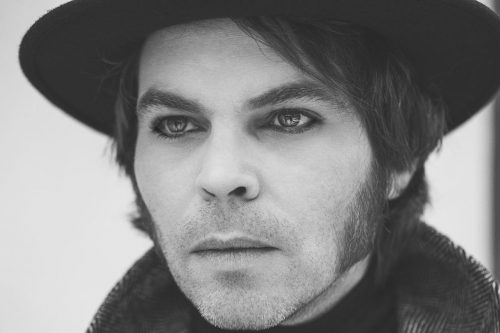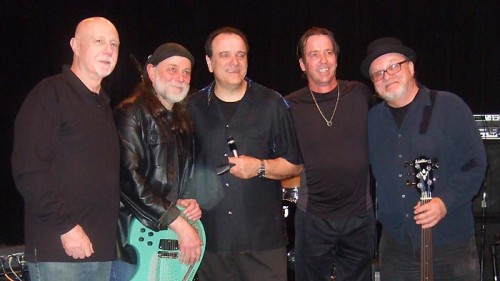On “World’s Strongest Man,” the latest album from Gaz Coombes, the former Supergrass frontman raises some serious concerns, like what it means to be a man in 2018 and mental health issues. But all Coombes was looking to do was express things he’s been thinking about for the past few years.
“I never really set out to make a record that highlighted those things in particular,” says Coombes from Chicago before a solo show there last week. “It always starts from like a personal angle. I think ‘World’s Strongest Man,’ the title track is more sort of looking at where I’m at and my quirks and what that means in terms of running your life and maintaining a sort of level headspace with your family, and the kind of job I do and writing music and how all of that fits in. Some days you feel like king of the world and other days you feel these flaws and weaknesses.”
Much of the press coverage for the album has drawn connection to the #MeToo movement, and Coombes notes, “I think totally there was a lot of that was speaking to me, shit that’s happened around the world, and outdated devices used by prehistoric men fucking it up for the rest of us, that definitely came up.”
“World’s Strongest Man,” however, is not a self-important, self-hating, anti-male screed — it tackles topics beyond men behaving badly. Layered and sonically diverse, its lyrical content is equally broad and deep. Indeed, the record, according to a press announcement made a few months before its release, was “inspired variously by Grayson Perry’s autobiography ‘The Descent of Man,’ Frank Ocean’s ‘Blonde,’ Californian weed, British woodlands, unchecked masculinity, Neu!, and hip hop.”
The album follows 2015’s “Matador,” which was nominated for a Mercury Prize, awarded to the best album released in the UK by a British or Irish act. The process of making the 2015 album carried into and inspired “World’s Strongest Man.”
“It’s sound writing more than songwriting from a sonic point of view.”
“I think the way that I wrote, it’s all quite instinctive, so I guess I’m finding my sound on the job, in the heat of the moment,” shares Coombes. “There’s no sort of big plan, I just start writing and recording. The style of the record, the directness of the record, it almost kind of writes itself in that way. I think there was a lot of learning in the writing of ‘Matador,’ in new techniques in recording and writing. That was a limited time period. I got 11 songs together in about six or eight months, so it’s almost like not enough time to explore the ideas that I had and further the ideas.”
Coombes’ US tour has two stops in New York this week: Tuesday, Oct. 2 at Mercury Lounge and Wednesday, Oct. 3 at Baby’s All Right in Brooklyn.
“It’s just me, a one-man show, but it’s great. It’s a bit more like the studio stuff and how I started writing it, so I sort of bring that kind of vibe onto the stage. I surround myself with a few kind of key things, electric guitar and drum machines and a keyboard and a looper.”
The “World’s Strongest Man” promotional push found Coombes making some high-profile TV appearances, including “Later … with Jools Holland” and “The Late Late Show with James Corden” two weeks ago. We ask Coombes if he sees quantifiable results — increased record sales, ticket sales or social media buzz, for example — from performing on such shows.
“It’s a dark art. Who knows? You can sometimes see immediate results with the TV thing or sometimes it’s a slow-burning thing. Sometimes it’s a cumulative thing and sometimes you do see immediate results.”
Supergrass, part of the ’90s Britpop wave that included bands like Oasis and Blur, was a melodic and hard-charging post-punk outfit, with guitars at the forefront. Coombes has taken a decidenly different direction since then — the music on “World’s Strongest Man” does not sound like something that sprung from strummed guitar.
“I can start on anything, I can start on a drum kit, play a drum beat that I had in my head, and then I’ll sort of jam with myself,” Coombes explains of his recording process, “then maybe I’ll jump on piano and start playing along to that beat. Nothing might come of it, it might sound rubbish, so I’ll start plunging myself into other things.
“It’s a bit of a laugh sonically, being expressive and having fun. The studio is a magical place to get out ideas. It’s sound writing more than songwriting from a sonic point of view; I hear a drum sound that directs me to the rest of it, that sort of being on my own and playing on my own.”
Coombes’ live shows feature a handful of Supergrass songs, but he’s gone out of his way to avoid being a tribute to himself.
“I did feel the pressure early on to play Supergrass stuff but I was quite stubborn and quite clear on what I wanted to do, to break away and do something different rather than go off with my acoustic guitar and strumming along to the Supergrass catalog,” the singer says. “There’s definitely a lot of skepticism with people, especially lead singers, leaving bands and doing their own thing, a ‘here we go again’ kind of mentality, but it’s been brilliant — I just made a few records and it’s been really well received.
“Many people have done it and done it really well. Paul Weller did a great job after The Jam, that’s someone I really admire.”
“I had some great hits over the years with Supergrass and some great songs, but I’m not going to live off those,” continues Coombes. “To rest on that legacy would be really boring to me. There’s too much to do and too many new ideas to settle for something like that.”
Gaz Coombes will perform Tuesday, Oct. 2 at Mercury Lounge (217 E. Houston St., New York, NY 10002) and Wednesday, Oct. 3 at Baby’s All Right (146 Broadway, Brooklyn, NY 11211).
Photo by Steve Keros




Leave a Reply